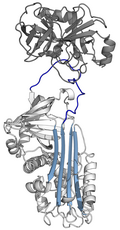Serpin
Serpin is a superfamily of proteins with over 1000 members identified in both animals and plants. These proteins share a common structure and are involved in a variety of biological processes, including blood coagulation, inflammation, immune response, and cell migration. Serpins function primarily as serine protease inhibitors, controlling the activity of proteases in these critical pathways. However, some serpins have evolved to inhibit other types of proteases or have entirely different functions unrelated to protease inhibition.
Structure and Mechanism[edit]
Serpins are characterized by a conserved tertiary structure, known as the serpin fold. This fold includes three β-sheets, eight or nine α-helices, and a reactive center loop (RCL) that acts as a bait for target proteases. Upon interaction with a protease, the RCL is cleaved, triggering a significant conformational change in the serpin. This change traps the protease in a covalent complex, inhibiting its enzymatic activity. This unique mechanism is referred to as a "suicide" or "mousetrap" mechanism.
Classification[edit]
Serpins are classified into clades based on their evolutionary relationships and functional similarities. The majority of serpins are found in the extracellular matrix, but some are located intracellularly. The human genome contains 36 serpin genes, which are categorized into clades A-I. Clade A serpins, such as antithrombin and alpha-1 antitrypsin, are primarily involved in the regulation of coagulation and inflammation. Clade B serpins, including ovalbumin, are found intracellularly and have a variety of functions.
Functions[edit]
The primary role of serpins is to regulate protease activity, ensuring that processes such as coagulation and inflammation proceed in a controlled manner. For example, antithrombin inhibits thrombin and other coagulation factors to prevent excessive blood clotting. Alpha-1 antitrypsin protects tissues from enzymes released by inflammatory cells, thus preventing damage during inflammation.
Beyond protease inhibition, some serpins have roles in tumor suppression, hormone transport, and neural development. The diversity of functions highlights the importance of serpins in maintaining physiological homeostasis.
Clinical Significance[edit]
Mutations in serpin genes can lead to diseases known as serpinopathies, which are characterized by the accumulation of serpin-protease complexes. For example, mutations in the SERPINA1 gene, which encodes alpha-1 antitrypsin, can lead to alpha-1 antitrypsin deficiency. This condition results in uncontrolled elastase activity, causing lung damage and liver disease. Similarly, deficiencies in antithrombin can increase the risk of thrombosis.
Research and Therapeutic Applications[edit]
Given their central role in many biological processes, serpins are targets for therapeutic intervention. Drugs that mimic or enhance serpin activity are being developed for conditions such as thrombosis, inflammation, and cancer. Additionally, understanding the mechanisms of serpinopathies is guiding the development of treatments for these genetic disorders.
Serpin[edit]
-
Serpin (stressed)
-
Serpin and protease
-
Serpin equilibrium
-
Serpin mechanism (S to R)
-
Serpin mechanism
-
Serpin activation by heparin (unannotated)
-
Serpin latent state (unannotated)
-
Serpin delta conformation
-
Domainswapped dimer
-
Antitrypsin domain swap
Ad. Transform your life with W8MD's Budget GLP-1 injections from $75


W8MD offers a medical weight loss program to lose weight in Philadelphia. Our physician-supervised medical weight loss provides:
- Weight loss injections in NYC (generic and brand names):
- Zepbound / Mounjaro, Wegovy / Ozempic, Saxenda
- Most insurances accepted or discounted self-pay rates. We will obtain insurance prior authorizations if needed.
- Generic GLP1 weight loss injections from $75 for the starting dose.
- Also offer prescription weight loss medications including Phentermine, Qsymia, Diethylpropion, Contrave etc.
NYC weight loss doctor appointmentsNYC weight loss doctor appointments
Start your NYC weight loss journey today at our NYC medical weight loss and Philadelphia medical weight loss clinics.
- Call 718-946-5500 to lose weight in NYC or for medical weight loss in Philadelphia 215-676-2334.
- Tags:NYC medical weight loss, Philadelphia lose weight Zepbound NYC, Budget GLP1 weight loss injections, Wegovy Philadelphia, Wegovy NYC, Philadelphia medical weight loss, Brookly weight loss and Wegovy NYC
|
WikiMD's Wellness Encyclopedia |
| Let Food Be Thy Medicine Medicine Thy Food - Hippocrates |
Medical Disclaimer: WikiMD is not a substitute for professional medical advice. The information on WikiMD is provided as an information resource only, may be incorrect, outdated or misleading, and is not to be used or relied on for any diagnostic or treatment purposes. Please consult your health care provider before making any healthcare decisions or for guidance about a specific medical condition. WikiMD expressly disclaims responsibility, and shall have no liability, for any damages, loss, injury, or liability whatsoever suffered as a result of your reliance on the information contained in this site. By visiting this site you agree to the foregoing terms and conditions, which may from time to time be changed or supplemented by WikiMD. If you do not agree to the foregoing terms and conditions, you should not enter or use this site. See full disclaimer.
Credits:Most images are courtesy of Wikimedia commons, and templates, categories Wikipedia, licensed under CC BY SA or similar.
Translate this page: - East Asian
中文,
日本,
한국어,
South Asian
हिन्दी,
தமிழ்,
తెలుగు,
Urdu,
ಕನ್ನಡ,
Southeast Asian
Indonesian,
Vietnamese,
Thai,
မြန်မာဘာသာ,
বাংলা
European
español,
Deutsch,
français,
Greek,
português do Brasil,
polski,
română,
русский,
Nederlands,
norsk,
svenska,
suomi,
Italian
Middle Eastern & African
عربى,
Turkish,
Persian,
Hebrew,
Afrikaans,
isiZulu,
Kiswahili,
Other
Bulgarian,
Hungarian,
Czech,
Swedish,
മലയാളം,
मराठी,
ਪੰਜਾਬੀ,
ગુજરાતી,
Portuguese,
Ukrainian










